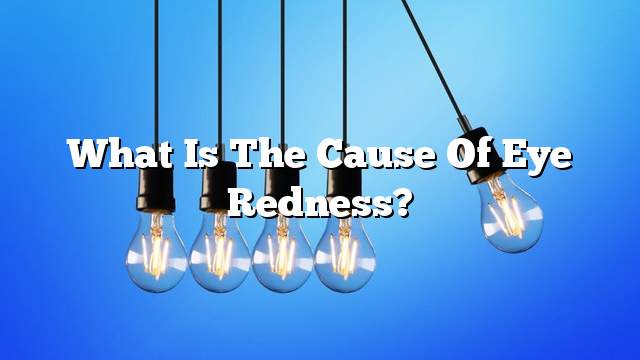Red eye
Red eye is the color of red eye, often resulting from conjunctivitis, dilated blood vessels, dry eye, or injury. Red eye may be a sign of the condition of the eye. Medical emergency in some cases, so it is advised not to neglect eye redness, and see the doctor to diagnose the situation, especially if the red eye continued for a long time.
Causes of eye redness
Causes of eye redness include:
- Inflammation of the eye, or the so-called pink eye, a disease caused by bacterial infection, conjunctiva is the transparent membrane that lining the inner part of the eyelid, and covers the eye whiteness (solid), and when inflamed conjunctiva widen the blood vessels, giving the eye a red color.
- Computer vision syndrome: When working for long hours on the computer, there is a decrease in the proportion of eyelash eyes, which leads to dry eye surface, and can reduce the stress of the eye when using the computer by following the following tips: wear glasses designed to work on the computer, And to keep the eyes fixed while working on the computer.
- Eye Injuries Eye injuries range from light scratches to wounds or chemical burns. When the eye is injured, the blood vessels dilate to allow blood to flow to the site to accelerate recovery. This causes the eye to appear red.
- Corneal ulcer.
- Herpes eye: Herpes infection produces the herpes simplex virus of type I, and in addition to eye redness causes eye pain, swelling, sensitivity to light, and frequent tears.
- Eye Dryness Dry eye results when the eye produces an insufficient amount of tears to moisten the eye, causing inflammation of the surface of the eye and irritation appears to be red, and can treat eye dryness using droplets, eye plugs to prevent fluid loss, and tears Industrial.
- Sensitivity: When the body is exposed to an allergen such as dust, animal skin, or contact lens solutions, the immune system responds to the secretion of histamine, which causes the expansion of the blood vessels in the eye and redness, and to treat this condition is recommended to use eye drops such as antihistamines.
- Contact lenses: Contact lenses cause redness of the eye for a number of reasons: they cause dry eyes, because they prevent oxygen from reaching the cornea, and may limit the ability of the eye to produce tears, especially when using lenses that are not suitable for the eye. Contact lenses by care for lenses, keeping them clean and sterile, changing them whenever needed, and using disposable lenses or high permeable (GP) lenses.
- Irrititis: Irrititis results from eye injury, inflammation, or autoimmune disorder, and causes redness of the eye, blurred vision, and sensitivity to light.
- Glaucoma (glaucoma) is caused by high eye pressure.
- Excessive use of eye whitening drops.
- Cold and Flu: Redness occurs as a result of inflammation or sinus obstruction.
- Hormonal changes during pregnancy: In addition to redness of the eyes cause blurred vision, dry eyes, itching, and sensitivity to light.
- Smoking: Tobacco is a poisonous substance that irritates the eye and causes redness.
- Alcohol consumption: Overuse of alcohol causes eye congestion and redness of the eyes.
- Exposure to environmental factors such as dust, smoke, very dry air, as well as materials that may be exposed to the human during his work such as: sand, sawdust, iron, etc., and to prevent these risks is advised to wear protective glasses.
- Do not sleep for long enough periods, rubbing the eye when feeling drowsy.
- Swimming: Wear swimming glasses to protect the eye from chlorine, bacteria that are naturally present in the water, cause red eyes, and refrain from using contact lenses while swimming; for fear of infection with the disease of the cornea ischemic (Acanthamoeba Keratitis).
- Chalazion: A mild congestion or bump inside the eyelid.
- hay fever.
- Orbital cellulitis: It is an acute inflammation of the tissues surrounding the eye, such as cheek, eyebrow, and eyelids.
Symptoms that require a doctor
Check with your doctor if red eye is associated with the following symptoms:
- The inability to keep an eye open.
- Pain in the eye, fever.
- Nausea or vomiting.
- Sudden vision disorder.
- Eye bulge.
- Light sensitivity.
- See the halos around the lights.
- Severe headache.
- Observation of a foreign object in the eye.
- Swelling of the eye.
Red eye treatment
To eliminate the redness of the eyes can follow the following tips:
- Apply warm compresses on the eye for ten minutes to increase blood flow to the eye, increasing the secretion of oils to help soften the eye.
- Cold compresses: If the eye does not respond to hot packs, cold compresses can be used to relieve eye irritation and swelling.
- Industrial tears: used to treat redness resulting from dry eye, in addition to its role in eye cleaning.
- If the redness is caused by the use of contact lenses, consult your doctor, replace contact lenses with suitable ones, and choose good lens preservation solutions.
- Drink enough water. You need 8 cups of water to maintain fluid balance.
- Limit the intake of foods that cause inflammation, which may increase the redness of the eye, such as: fast food, dairy products, processed foods.
- If your eye condition does not improve, you should see a doctor who may prescribe antihypertensives and antibiotics.
